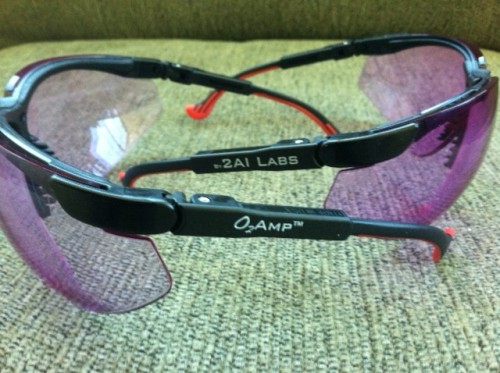The O2Amp amplifies perception of emotions, moods and health. Really.
One of the “7 Major Health Innovations of 2012 that Matter”.
And, no, they’re not merely tinted glasses. …gray (non-pink) versions coming soon.

As seen in TIME Magazine, Technology Review, and WIRED, the world’s first eyewear designed to enhance the visibility of blood beneath the skin, giving doctors, nurses and other medical personnel a clearer view of vasculature, oxygenation, and trauma.
The O2Amp furnishes superior powers of clinical assessment and diagnosis, better visualizations for procedures and blood work, and is a central piece of medicine’s next-generation toolkit. Eye protection, but with an enhanced perception of health.
Comfortably wear it all day, or quickly pull it out as needed, whether it’s emergency medicine, surgery, dermatology, neonatology or elsewhere.
“It looks like my vision is compensated with Photoshop,” says neurosurgeon Dr. Kei Nomura, Chief of Center for Brain and Spine Surgery, Aoyama General Hospital.
We at 2AI Labs are excited to have our first spin-off company, O2Amps, the home of our patented eyewear and light filtering technology that amplifies one’s view of the emotions and health visible in the color and pallor of other people’s skin.
The technology comes out of my research while at Caltech on the evolution of color vision in primates, where I provided evidence that color vision evolved to sense oxygenation modulations in the hemoglobin under the skin. Once one understands the connection between our color vision and blood physiology, it’s possible to build filters that further amplify our perception of the blood and the signals it provides (a patented invention by myself and my co-director, Tim Barber).

Because color vision evolved for everyday wear, so to speak, one of our largest markets is for everyday-wear sunglasses, to enhance one’s perception of the emotion, mood and health signals we evolved to detect with our color vision. For example, typical sunglasses shade the world but also end up shading one’s connections to other people; this is exemplified by the way people tip up their sunglasses to get a better look at someone. Our technology shades the world but not the social; for the O2Amps, one sees other people better by keeping them on, rather than tipping them up.
There are also applications in security, sports, poker, and dating. (See projects in development.)
And there are applications in medicine, which is where we believe we can make the greatest impact. In fact, for medicine we have developed three different technologies, and they can be described as…
— (i) Oxy-Iso: An oxygenation-isolator that amplifies perception of oxygenation modulations under the skin (and eliminates perception of variations in the concentration of hemoglobin),
— (ii) Hemo-Iso: A trauma-detector, or hemoglobin-concentration-isolator, that amplifies perception of hemoglobin concentrations under the skin (and eliminates perception of variations in oxygenation), and
— (iii) Oxy-Amp: A general clinical enhancer, or oxygenation-amplifier, that combines the best features of the first two; it eliminates neither signal (i.e., it retains perception of both variation in hemoglobin oxygenation and concentration), and only amplifies perception of oxygenation. It provides a strict enhancement to exactly the thing primate color vision evolved to sense.
We’ve received great interest from medical professionals interested in trying out the O2Amp, and we’re moving now to get them in hospitals and among clinical staff everywhere.
We’re also moving into lighting, where entire spaces can be filled with the same filtered light. …no eyewear needed.
We believe our Oxy-Amp is the new starting point for lens blanks.
Colorblind folk have found that the Oxy-Iso provides a big help for their red-green blindness.
See the O2Amp site for all our projects in development.
Note that good light is needed for the technology, by which we mean outdoor lighting or a head lamp.
Some useful links:
– The start-up for this technology… o2amp.com
– Video from Daily Planet television show, Discovery Channel.
– ABC News’ This Could Be Big Television.
– Introductory video (by filmmaker Emon Hasson)… Intro video
– Some testimonials… Testimonials
– More testimonials
– What one sees… Illustration, Description
– Train yourself… in five steps (text only version).
– The research article on the evolution of color vision… Journal article
Some of the press interest in o2amp.com:
MSNBC, Sciencebase, Tech Rev, Betabeat, PopSci, ExameInformatica, Smithsonian, LiveScience/Yahoo, WIRED, NZ Herald, Investors, DesignBoom, Mobiledia, Discovery, PSFK, Neoteo, Earthsky, Good, Wissenundkonzepte, Stuff, Forbes, Actualidad, Geek, Gizmodo, PSFK, Neatorama, TIME, Oprah, BBC, DarkDaily; Lost At E Minor, ZenniOptical. Prevention Magazine, Scientific American / Txchnologist, Slashdot, Diffusion Radio, io9, The Times UK [subscription], BBC, Discovery News, Daily Mail UK, New Scientist, Smart Planet, CBC, Unexplained Mysteries, Telegraph, Voice of Russia, Geek Chic Mama, NY Daily News, GizMag, The Argus, Elite Daily, Columbia Chronicle, Under the Gun, Today, PopSci,
ABC News’ This Could Be Big.
Also, listed as one of the “7 Major Health Innovations of 2012 that Matter”.
~~~
Mark Changizi is Director of Human Cognition at 2AI, and the author of Harnessed: How Language and Music Mimicked Nature and Transformed Ape to Man and The Vision Revolution. He is finishing up his new book, HUMAN 3.0, a novel about our human future.
















